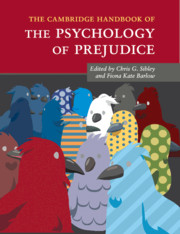Book contents
- Frontmatter
- Dedication
- Contents
- List of Figures
- List of Tables
- Notes on the Contributors
- Part I General Theoretical Perspectives
- Part II Prejudice in Specific Domains
- Part III Prejudice Reduction and Analysis in Applied Contexts
- 20 Recent Developments in Intergroup Contact Research: Affective Processes, Group Status, and Contact Valence
- 21 From Prejudice Reduction to Collective Action: Two Psychological Models of Social Change (and How to Reconcile Them)
- 22 Self-Regulation Strategies for Combatting Prejudice
- 23 Antecedents and Consequences of Evaluative Concerns Experienced During Intergroup Interaction: When and How Does Group Status Matter?
- 24 Stereotypicality Biases and the Criminal Justice System
- 25 Prejudice, Stigma, Bias, Discrimination, and Health
- 26 Development of Delegitimization and Animosity in the Context of Intractable Conflict
- 27 Interventions in Real-World Settings: Using Media to Overcome Prejudice and Promote Intergroup Reconciliation in Central Africa
- 28 Identification with All Humanity: The Antithesis of Prejudice, and More
- 29 It's All About Ignorance: Reflections from the Blue-eyed/Brown-eyed Exercise
- Index
- References
24 - Stereotypicality Biases and the Criminal Justice System
from Part III - Prejudice Reduction and Analysis in Applied Contexts
Published online by Cambridge University Press: 17 November 2016
- Frontmatter
- Dedication
- Contents
- List of Figures
- List of Tables
- Notes on the Contributors
- Part I General Theoretical Perspectives
- Part II Prejudice in Specific Domains
- Part III Prejudice Reduction and Analysis in Applied Contexts
- 20 Recent Developments in Intergroup Contact Research: Affective Processes, Group Status, and Contact Valence
- 21 From Prejudice Reduction to Collective Action: Two Psychological Models of Social Change (and How to Reconcile Them)
- 22 Self-Regulation Strategies for Combatting Prejudice
- 23 Antecedents and Consequences of Evaluative Concerns Experienced During Intergroup Interaction: When and How Does Group Status Matter?
- 24 Stereotypicality Biases and the Criminal Justice System
- 25 Prejudice, Stigma, Bias, Discrimination, and Health
- 26 Development of Delegitimization and Animosity in the Context of Intractable Conflict
- 27 Interventions in Real-World Settings: Using Media to Overcome Prejudice and Promote Intergroup Reconciliation in Central Africa
- 28 Identification with All Humanity: The Antithesis of Prejudice, and More
- 29 It's All About Ignorance: Reflections from the Blue-eyed/Brown-eyed Exercise
- Index
- References
Summary
Michael Brown, age 18. Tony Robinson, age 19. Amadou Diallo, age 22. Oscar Grant III, age 22. Freddie Gray, age 25. Akai Gurley, age 28. Jerame Reid, age 36. Eric Garner, age 43. Tamir Rice, age 12. These are just some of the names of innocent Black men (and, in the case of Tamir Rice, boys) who fell prey to the use of deadly force by police officers over the past few years in the United States. Although these victims vary considerably in terms of their age, their place of residence, and the circumstances surrounding their death, a common thread unites them; they all poignantly bring to light race-based injustices within the criminal justice system.
Unfortunately, racial disparities in the courts have long been noted (Alexander, 2010; Snowball & Weatherburn, 2007; Sudbury, 2013). For example, research from the United States shows that Blacks are nearly seven times more likely than Whites to serve time in prison by the time they reach their early 30s (Pettit & Western, 2004). Though some argue that these disparities are based on different rates of offending and other legitimate factors (see Klein, Petersilia, & Turner, 1990), studies show that after controlling for various legally relevant factors, race-based differences in criminal justice outcomes still exist (see Austin & Allen, 2000; Bales & Piquero, 2012; Mitchell & MacKenzie, 2004). In short, racial disparities can be found throughout the criminal justice system.
To a certain extent, race-based injustices such as the ones noted above may be (partly) explained – though certainly not excused – by the implicit associations that exist between race and crime (see Eberhardt, Goff, Purdie, & Davies, 2004). Specifically, Yogeeswaran, Devos, and Nash (Chapter 11, this title) note that implicit biases originate from socialization processes and operate outside of awareness. As such, crime-related stereotypes about Blacks may lead police officers and others within the criminal justice system to unintentionally misinterpret ambiguous information in a stereotype-consistent manner (see Levinson & Young, 2010). When involving life-or-death decisions, these basic cognitive biases may give rise to the unnecessary use of deadly force. In other words, basic psychological processes that underlie stereotyping and implicit biases may (partially) account for the noted racial disparities found in the courts (for a detailed review of the literature on implicit biases, see Yogeeswaran et al. (Chapter 11, this title).
- Type
- Chapter
- Information
- The Cambridge Handbook of the Psychology of Prejudice , pp. 542 - 558Publisher: Cambridge University PressPrint publication year: 2016



